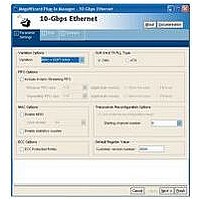IP-10GETHERNET Altera, IP-10GETHERNET Datasheet - Page 86

IP-10GETHERNET
Manufacturer Part Number
IP-10GETHERNET
Description
IP CORE - 10 Gbps Ethernet MAC PCS PMA Reference Design
Manufacturer
Altera
Datasheet
1.IP-10GETHERNET.pdf
(86 pages)
Specifications of IP-10GETHERNET
Software Application
IP CORE, Interface And Protocols, ETHERNET
Supported Families
Quartus II
Core Architecture
FPGA
Core Sub-architecture
Stratix
Rohs Compliant
NA
Lead Free Status / RoHS Status
na
Copyright © 2010 Altera Corporation. All rights reserved. Altera, The Programmable Solutions Company, the stylized Altera logo, specific device designations, and all other words
and logos that are identified as trademarks and/or service marks are, unless noted otherwise, the trademarks and service marks of Altera Corporation in the U.S. and other coun-
tries. All other product or service names are the property of their respective holders. Altera products are protected under numerous U.S. and foreign patents and pending
applications, maskwork rights, and copyrights. Altera warrants performance of its semiconductor products to current specifications in accordance with Altera's standard warran-
ty, but reserves the right to make changes to any products and services at any time without notice. Altera assumes no responsibility or liability arising out of the application or use
of any information, product, or service described herein except as expressly agreed to in writing by Altera Corporation. Altera customers are advised to obtain the latest version of
device specifications before relying on any published information and before placing orders for products or services
Table 3–57. Clock Signals (Part 2 of 2)
avalon_clk
avl_st_clk
xgmii_rx_clk
xgmii_tx_clk
serdes_sysclk
phy_mdc
cal_blk_clk
Signal
For the definition of reconfig_clk, refer to
page
The Avalon-MM clock that controls the Avalon-MM interface used for statistics and configuration.
This clock can be shared with other modules, an SOPC system, or can be tied to the system clock.
Avalon-ST clock input for the datapath, which can be different if a FIFO is present. This clock can
be tied to the system clock.
Captures the data arriving on the XGMII Rx interface, a PLL and local clock are required. The
incoming clock is shifted by 90 degrees to capture the data.
Clock that accompanies xgmii_tx_data and xgmii_tx_ctrl. It is shifted by 90
respect to xgmii_tx_data and xgmii_tx_ctrl.
XAUI clock. When using the XAUI block, the transceiver module has its own PLL to derive the
required output clocks. You can feed both the Tx and Rx data clock, which are connected to the
system clock, and the clock domain crossing from network clock to system clock occurs within
the transceiver block.
MDIO clock. The frequency of the MDIO must be less than 2.5 MHz and is derived from the
Avalon-MM clock. the MDIO clock cannot be shared between modules.
SERDES calibration clock. The frequency of this clock should be between 10–125 MHz.
3–55.
Description
“Top-Level Transceiver Signals” on
.
°
with









